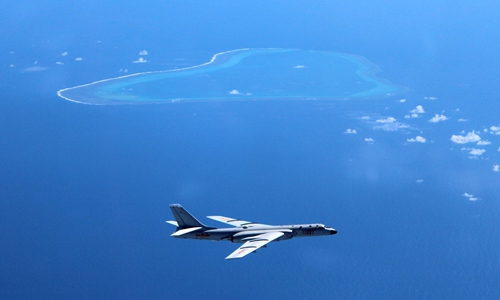US pushes S.China Sea hegemony amid pandemic
By Chen Xiangmiao Source:Global Times Published: 2020/4/30 17:39:32

File photo shows a Chinese H-6K bomber patrolling islands and reefs including Huangyan Dao in the South China Sea. (Xinhua/Liu Rui)
The US Navy said on April 21 that the USS America and two other vessels entered the South China Sea. In the face of the raging coronavirus epidemic in the US, Washington has shown no intention to halt pressuring China on the South China Sea issue.
The USS America, the most important operational naval asset in the South China Sea, was carrying out the latest operation when the coronavirus-hit aircraft carrier USS Theodore Roosevelt is docked in Guam.
Washington's decision-makers have clear and definite expectations over the South China Sea, which is to maintain US dominant position in setting the agenda and leading discourse that is aimed at securing its leadership in the region.
Yet, even as the deadly coronavirus spreads around the world and international political and economic order is about to significantly adjust, Washington seems determined to intervene in the waters.
US recent moves in the South China Sea seem weird from the perspective of both its operational capability and actual security needs. The US military in the Western Pacific has been severely affected by the coronavirus. Reports show over 40 US navy warships have had sailors test positive of the virus.
Meanwhile, China - the imaginary enemy of the US - has restricted its involvement in the South China Sea since the end of January, as it spared no effort in curbing the epidemic, resuming work and production, and participating in international assistance.
In addition to pursuing regional leadership, Washington hopes to stabilize its alliance and partnerships in the Asia-Pacific region and other parts of the world through its excessive engagement in the South China Sea during the outbreak.
US Secretary of State Mike Pompeo said on April 23 that China is "taking advantage" of the worldwide pandemic to promote its territorial ambition in the South China Sea. The accusation exemplifies US attempts to hype the so-called China threat by linking COVID-19 outbreak with the South China Sea issue in order to boost relations with its allies and partners.
US allies and partners doubt the super power is willing and capable of maintaining its leadership due to Trump administration's pursuit of unilateralism in the global economy, security and governance, and the power evolution between China and the US in the Asia-Pacific region. The Trump administration has not offered timely help to the EU and other countries during their COVID-19 fight. Instead, Trump has vented his anger at the World Health Organization and constantly blamed China over the origin of the virus without solid proof. These moves have disappointed the international community.
Meanwhile, China has been proactively sharing its anti-virus experience and medical resources with other countries. The South China Sea issue has thus become one of the most important tools for the US to show its strength and determination in maintaining the US-dominated security architecture in the Asia-Pacific.
The US claims that democracy and freedom are the basis for its leadership. But the most important aspect of the US alliance is perpetuating the so-called threat from Russia and China that is a leftover from the Cold War.
Since former US president Barack Obama administration, the US has been hyping China's so-called threat for its "expansion" in the South China Sea. The Trump administration is going further on the path. It has been trying to rope in its allies and partners, hoping they will pick sides in the geopolitical competition in the South China Sea. The Trump administration has portrayed China's South China Sea strategy as a common threat facing US allies, in an attempt to make up for the losses caused by its unilateralism.
US allies and partners will not lose confidence in the US in a short time. Washington cannot easily regain its prestige, and it will thus maintain its strategy regarding the South China Sea issue as a leverage in the region.
Avoiding potential conflicts and crises between China and the US in the South China Sea is now more urgent than ever. It seems that the existing US-China Memorandum of Understanding On the Rules of Behavior for the Safety of Air and Maritime Encounters no longer meets the two countries' needs in preventing and controlling conflicts in the region. China and the US still need to establish a high-level consensus.
The South China Sea issue should be differentiated from China-US competition, to prevent their contradictions from escalating out of control. It is hoped that decisions-makers from the two countries could establish a strategic consensus to avoid a possible arms race as the two compete for spheres of influence.
The author is an assistant research fellow at the National Institute for South China Sea Studies. opinion@globaltimes.com.cn
Posted in: VIEWPOINT,CHINA-US